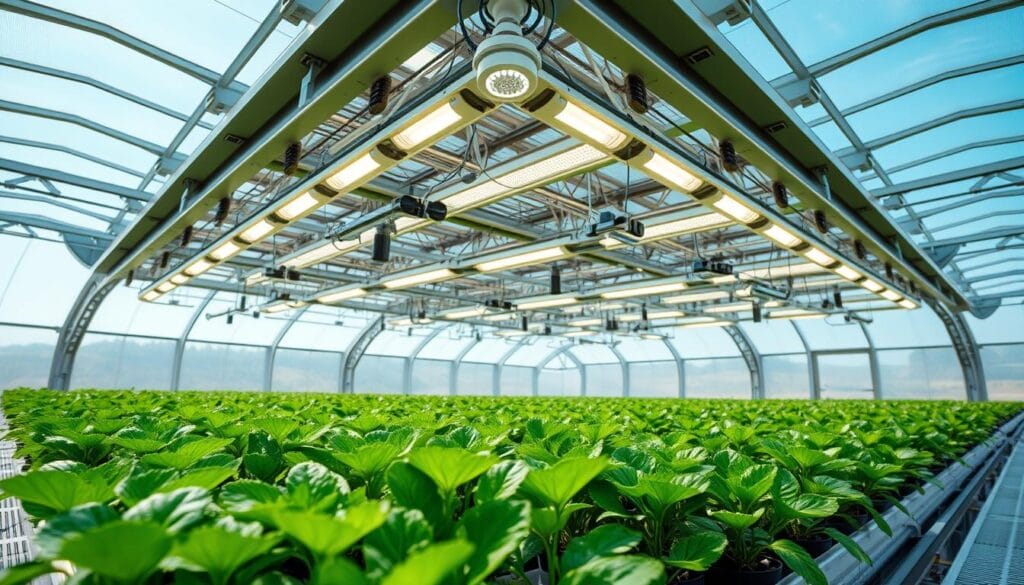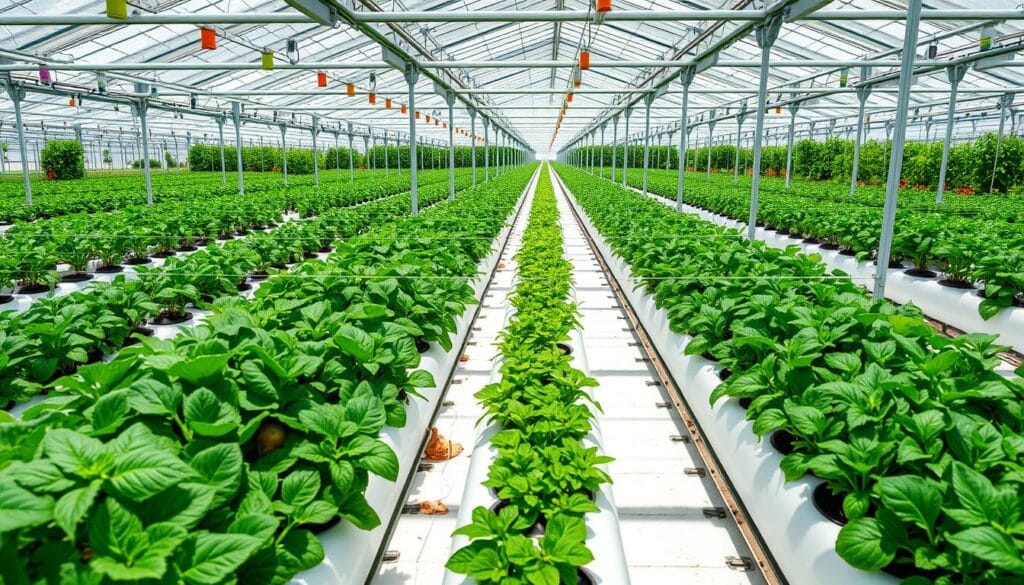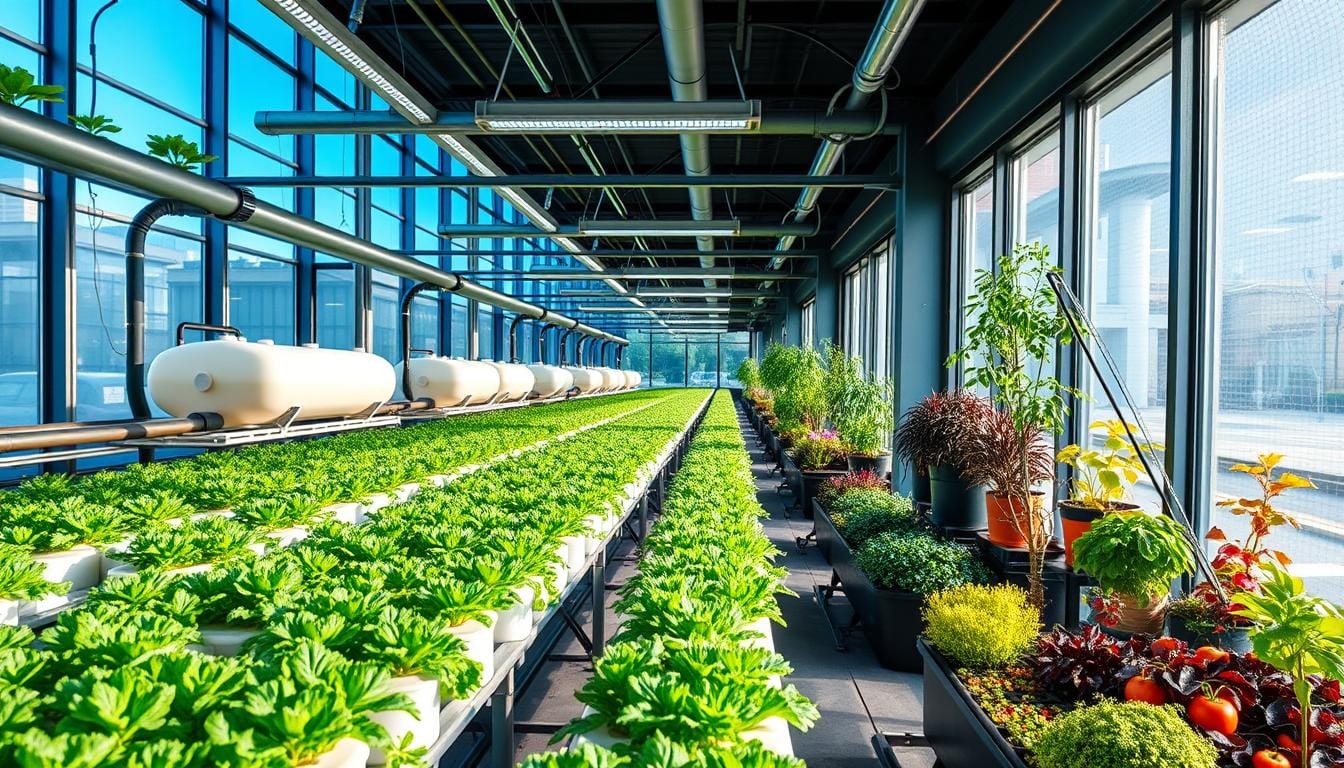Hydroponics farms are revolutionizing agriculture with their innovative methods. It grows crops without soil, using water full of nutrients. This method saves a lot of water and makes the most of small spaces.
It lets farmers grow food all year round, even in places where regular farming is hard. The hydroponics market was worth $5.00 billion in 2023. It’s growing fast, showing how hydroponics farms are changing farming for the better.
Key Takeaways
- Hydroponics uses up to 90% less water compared to traditional agriculture.
- Plants grow 25-30% faster in hydroponic systems due to direct access to nutrients.
- Vertical hydroponic systems enable farmers to optimize their space, making them particularly suited for urban environments.
- Hydroponics is being embraced by a wide range of industries, including nonprofits, schools, healthcare, and zoos.
- Freight Farms offers customizable hydroponic farming solutions for individual growers or large-scale operations.
Understanding Modern Soilless Agriculture
Hydroponics Farms: Hydroponics farms represent a modern approach to growing plants without soil. These farms utilize a soilless method that revolutionizes food production, providing plants with essential nutrients directly from water rather than relying on soil.
What Makes Hydroponics Different from Traditional Farming
Hydroponics is different because it doesn’t use soil. Instead, it gives plants nutrients in water. This makes plants grow faster and stronger.
The Science Behind Water-Based Plant Growth
Hydroponics works by giving plants what they need in water. Plants get oxygen, nutrients, and water right to their roots. This makes growing plants more efficient and productive.
Core Components of Hydroponic Systems
- Nutrient solution: A mix of minerals and nutrients for plants.
- Growing medium: Stuff like coco coir or rockwool for roots.
- Environmental control mechanisms: Systems for temperature, humidity, and light.
These parts work together for a perfect growing space. It’s efficient and boosts plant health and growth.
The Evolution of Hydroponics Farm Technology
Hydroponics is the art and science of growing plants in nutrient-rich water. It has changed a lot over the years. From ancient Hanging Gardens of Babylon to today’s vertical farms, it shows human creativity and the need to change farming.
The Aztecs had floating gardens called “chinampas” in the 10th and 11th centuries. The Hanging Gardens of Babylon also used hydroponics to grow plants in a dry place.
In the 17th and 19th centuries, scientists like Jan Baptist van Helmont and Jean-Baptiste Boussingault started studying hydroponics. The 20th century brought big changes, thanks to William Frederick Gericke, known as the “Father of Hydroponics.”
Now, hydroponics is a modern industry with advanced technologies. Vertical farming uses space well by stacking trays. Aquaponics links hydroponics with fish farming, making use of resources better.
New technologies like automation and energy-saving lights have helped hydroponics grow. Automated systems control nutrients and other factors, making crops better and more consistent.
Hydroponics is key to solving food, water, and farming problems. It uses technology to grow food efficiently and with less harm to the environment.
“Hydroponics represents the future of farming, offering an efficient and sustainable method to meet the rising food needs in our fast urbanizing society.”
Essential Components of Hydroponic Growing Systems
To grow healthy plants in hydroponic systems, gardeners need to know the key parts. These parts work together to create the best growing space. They include managing nutrients, using advanced lights, and controlling the climate.
Nutrient Solution Management
The nutrient solution is vital for plants in hydroponic systems. This method supplies the necessary nutrients for healthy plant development. Growers must keep an eye on the solution’s pH, oxygen, and temperature to help plants thrive.
Lighting and Climate Control Systems
Hydroponic farming aims to mimic perfect growing conditions. Grow lights, often LED, provide the light plants need. Climate control systems keep the temperature and humidity right for plants to grow well.
Water Circulation and Filtration Equipment
Good water management is key in hydroponic systems. Water pumps move the nutrient solution around, ensuring plants get enough. Filtration keeps the water clean, helping plants stay healthy.
By understanding these key components, hydroponic growers can create a productive space. This space lets plants grow well without soil.
| Component | Function |
|---|---|
| Nutrient Solution | Provides plants with essential macro- and micronutrients for growth |
| Grow Lights | Simulate sunlight and offer the full light spectrum needed for plant development |
| Water Pumps | Circulate the nutrient solution throughout the system for even distribution |
| Filtration Equipment | Remove impurities and maintain water quality for healthy plant growth |
| Climate Control Systems | Regulate temperature, humidity, and ventilation for optimal growing conditions |
Popular Hydroponic Growing Methods
Hydroponic growing methods are changing the way we grow plants. They don’t need soil to thrive. The Nutrient Film Technique (NFT), Deep Water Culture (DWC), and Aeroponics are among the favorites.
The Nutrient Film Technique (NFT) uses a thin film of nutrient-rich water. It flows over the plant roots constantly. This method is great for small crops like microgreens because it saves space and resources.
In Deep Water Culture (DWC) systems, roots hang in nutrient-rich water. This way, plants get the nutrients they need efficiently. It’s perfect for growing bigger crops like leafy greens and herbs.
Aeroponics feeds roots with a nutrient mist while they hang in the air. It can make plants grow faster and yield more. But, it needs careful control of the environment.
Other methods like Ebb and Flow, Drip, and Wicking systems also have their perks. The right method depends on the crop, environment, and goals.
| Hydroponic Method | Description | Suitable Crops |
|---|---|---|
| Nutrient Film Technique (NFT) | Thin film of nutrient-rich water flowing continuously over plant roots | Microgreens, leafy greens, herbs |
| Deep Water Culture (DWC) | Plant roots suspended directly in nutrient-enriched water | Leafy greens, herbs, some vegetables |
| Aeroponics | Mist of nutrient solution sprayed on suspended plant roots | Leafy greens, herbs, some vegetables |
Each hydroponic method has its own benefits. They suit different crops and growing conditions. Knowing these methods helps growers choose the best one for their soilless farming.
Nutrient Management and Water Efficiency
Keeping the right nutrient levels is key for a successful hydroponic farm. The nutrient ratios needed can change based on the crop. It’s important to check and adjust the pH balance of your nutrient solution often. This helps plants absorb the nutrients they need.
Optimal Nutrient Ratios for Different Crops
Each crop needs different nutrients. Leafy greens might need more nitrogen, while fruiting plants need more potassium and phosphorus when they’re producing fruit. Adjusting your nutrient solution for each crop can help them grow better.
Water Conservation Techniques
Hydroponics is great for saving water. This method can reduce water usage by as much as 90% compared to traditional agricultural practices. This is because hydroponics recycles water and delivers nutrients precisely, reducing waste. Using water efficiency methods can lower your environmental impact and costs.
pH Balance and Monitoring
Keeping the right pH balance in your hydroponic system is vital. Most plants do best in a pH range of 5.5 to 6.5. You need to keep checking and adjusting the pH and nutrient levels to keep your plants healthy and productive.
| Parameter | Ideal Range |
|---|---|
| pH | 5.5 – 6.5 |
| Dissolved Oxygen (DO) | 5 – 7 ppm |
| Oxidation-Reduction Potential (ORP) | 200 – 350 mV |
By focusing on nutrient management and water efficiency, you can make your hydroponic farm more productive and sustainable. Always check and adjust important factors like pH, nutrient levels, and water use. This will help your plants do well in your hydroponic system.
Environmental Control and Automation
In the world of controlled environment agriculture, keeping the environment just right is key. Hydroponics, a method without soil, needs these perfect conditions. Things like temperature, humidity, CO2 levels, and light are all controlled to help plants grow well.
Automation is the heart of these advanced hydroponic systems. Artificial intelligence and machine learning help watch and adjust these conditions as needed. This means plants get the best care, and it saves on labor costs too.
The perks of environmental control and automation in hydroponics are many. Growers can get plants to grow faster, produce more, and grow all year round. This is all done in a small space, making hydroponics great for cities and places with limited space.
| Hydroponic Technique | Advantages |
|---|---|
| Nutrient Film Technique (NFT) | Consistent nutrient delivery, high oxygen availability, and efficient water use |
| Deep Water Culture (DWC) | Simplicity, low maintenance, and effective oxygenation of plant roots |
| Aeroponics | Highest oxygen availability for roots, reduced water and nutrient usage |
| Dutch Bucket | Ideal for vining and fruiting crops, easy to maintain and scale |
As controlled environment agriculture grows, so does the need for better automation and control. These technologies will keep driving innovation and making food production more efficient and sustainable.

“Automated systems in hydroponics can regulate temperature, humidity, lighting, and nutrient delivery with a level of precision that simply isn’t possible with traditional farming methods.”
Maximizing Crop Yields in Controlled Environments
In the fast-changing world of hydroponic farming, growers look for ways to boost crop yields. They aim to make their controlled environment agriculture (CEA) systems more efficient. By adjusting growth rates, using space wisely, and harvesting with precision, hydroponic farmers can reach their full potential.
Growth Rate Optimization
Hydroponic systems have a big advantage in growth rate. Growers control nutrients, light, temperature, and humidity to speed up plant growth. This leads to faster maturation and more harvests, increasing crop yields compared to traditional farming.
Space Utilization Strategies
Hydroponic vertical farming makes the most of space. Growers stack grow beds or use vertical towers to grow more plants in less space. This strategy boosts harvest optimization and increases the system’s productivity.
Harvest Timing and Techniques
Getting the harvest right is key for quality and crop yields. Hydroponic growers watch plant growth, environment, and market demand to know when to harvest. They use special techniques to pick crops at their best, keeping flavor, texture, and nutrition high.
By focusing on growth, space, and harvest, hydroponic farmers can achieve top vertical farming results. They deliver more sustainable, high-quality food to meet growing demand.
| Key Hydroponic Advantages | Traditional Farming | Hydroponic Farming |
|---|---|---|
| Crop Yields | Up to 3 harvests per year | Up to 18 harvests per year |
| Crop Density | 1x | 16x |
| Growth Rate | 1x | 30% faster |
| Water Usage | 1x | 90% less |
“Hydroponics enables us to produce more food in smaller areas while conserving water and eliminating soil, making it a sustainable solution for the future.”
Commercial Applications and Market Potential
The hydroponics market is growing fast, thanks to new uses for this tech. It’s used in big urban farms and for making medicines and cosmetics. The market was worth USD 35.2 Billion in 2022 and could hit USD 58.3 Billion by 2030. It’s expected to grow at 7.5% each year from 2023 to 2030.
More people want food grown locally and without pesticides. Hydroponics can grow top-quality crops all year, no matter where you are. This makes it a great choice for many businesses, from restaurants to space programs.
| Key Hydroponics Market Insights | Value |
|---|---|
| Global Hydroponics Market Value (2022) | USD 35.2 Billion |
| Projected Global Hydroponics Market Value (2030) | USD 58.3 Billion |
| Compound Annual Growth Rate (CAGR) 2023-2030 | 7.5% |
| Largest Market Segment (2022) | Liquid Hydroponic Systems |
| Largest Application Segment (2022) | Vegetables |
| Largest End-Use Segment (2022) | Indoor Farming |
| Largest Regional Market (2022) | Europe |
The commercial hydroponics market is set to grow a lot. Both small and big farms are using this tech. With more focus on urban farming and green food, hydroponics’ future looks very promising.

Conclusion
Hydroponics is a key solution to global food challenges. It saves water, uses less land, and grows more food. This makes it a great choice for farming’s future.
As technology gets better and costs go down, hydroponics will help feed more people. It’s a big step towards a sustainable food system.
The way we farm will change a lot. Hydroponics beats old farming methods in many ways. It grows food faster, uses less water, and fights pests better.
Hydroponics can grow many types of food. This is good for both small urban farms and big commercial ones. It’s a flexible and efficient way to farm.
With climate change, growing populations, and the need for green food, hydroponics is key. Using this tech helps make our food system better. It ensures a green future for future of farming, sustainable agriculture, and food security.

